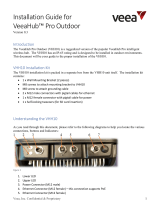
Contents
1. INTENDED USE ................................................................................................................................................. 5
2. WARRANTY CONDITIONS ............................................................................................................................... 5
3. MAINTENANCE ACTIVITIES ............................................................................................................................ 6
3.1. Cleaning Stainless Steel Components ........................................................................................................ 6
3.2. Cleaning ABS Components......................................................................................................................... 6
3.3. Cleaning Platform Scales for Meat Industry ................................................................................................ 6
4. SERVICE AND REPAIR ..................................................................................................................................... 8
5. RECYCLING ....................................................................................................................................................... 8
6. MECHANICAL DESIGN ..................................................................................................................................... 9
6.1. 1-Load-Cell Scales ...................................................................................................................................... 9
6.2. Multiple Load Cell Scales ............................................................................................................................ 9
6.3. Scales with Load-Cell Modules ................................................................................................................. 10
6.4. Dimensions ................................................................................................................................................ 11
6.5. Connectors ................................................................................................................................................ 11
6.6. Pins Arrangement ...................................................................................................................................... 12
6.7. Inputs / Outputs ......................................................................................................................................... 13
6.7.1. Technical Specifications ................................................................................................................. 13
6.7.2. I/O Schematic Diagrams ................................................................................................................ 14
6.8. Operation Panel......................................................................................................................................... 14
7. SCALE INSTALLATION .................................................................................................................................. 15
7.1. Unpacking and Installation ........................................................................................................................ 15
7.1.1. 1-Load-Cell Multifunctional Scales ................................................................................................. 15
7.1.2. Platform Scales: HX7.4.xx.C, HX7.4.xx.H, HX7.4.xx.H/Z Series .................................................. 16
7.1.3. Ramp Scales: HX7.4N Series ........................................................................................................ 16
7.1.4. Track Scales: HX7.2K Series ......................................................................................................... 17
7.2. Levelling: 1-Load-Cell Platform Scales ..................................................................................................... 17
7.3. Levelling: 4-Load-Cell Platform Scales ..................................................................................................... 17
7.4. Start-Up ..................................................................................................................................................... 18
7.5. Battery Status ............................................................................................................................................ 18
8. HOME SCREEN ............................................................................................................................................... 19
8.1. Top Bar ...................................................................................................................................................... 19
8.2. Weighing Result Window .......................................................................................................................... 20
8.3. Workspace ................................................................................................................................................. 20
8.4. Pictograms ................................................................................................................................................. 20
9. OPERATING THE MENU ................................................................................................................................. 20
9.1. Entering the Menu ..................................................................................................................................... 20
9.2. Menu Keys ................................................................................................................................................. 21
9.3. Entering Numbers / Text ........................................................................................................................... 22
9.3.1. Numerical Box ................................................................................................................................ 22
9.3.2. Text Box.......................................................................................................................................... 23
9.3.3. Diacritical Sign Table ...................................................................................................................... 25
9.3.4. Special Sign Table.......................................................................................................................... 25
9.4. Return to Weighing .................................................................................................................................... 26
10. WEIGHING ..................................................................................................................................................... 26
10.1. Operation conditions for 1-load-cell-scales ............................................................................................. 26
10.2. Operation conditions for special scales .................................................................................................. 27
11. DIAGRAMS OF CONNECTION CABLES ..................................................................................................... 28
12. TECHNICAL SPECIFICATION ...................................................................................................................... 30
13. ERROR MESSAGES ..................................................................................................................................... 30






















